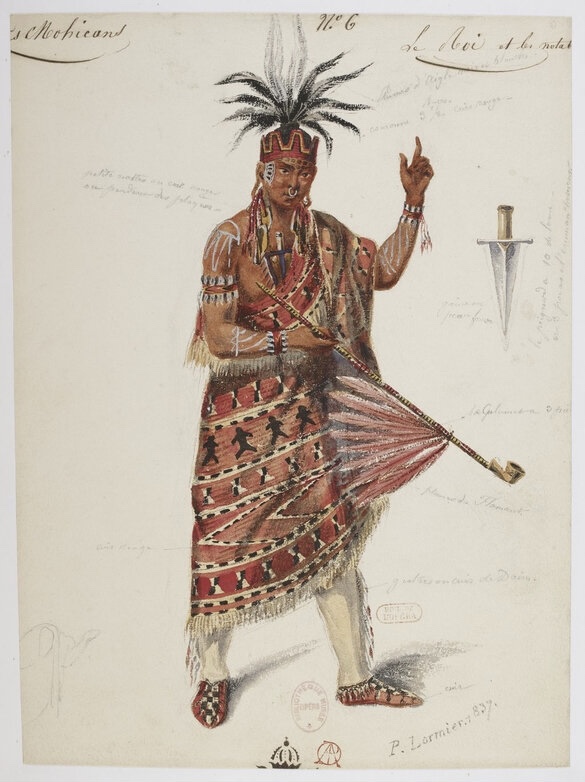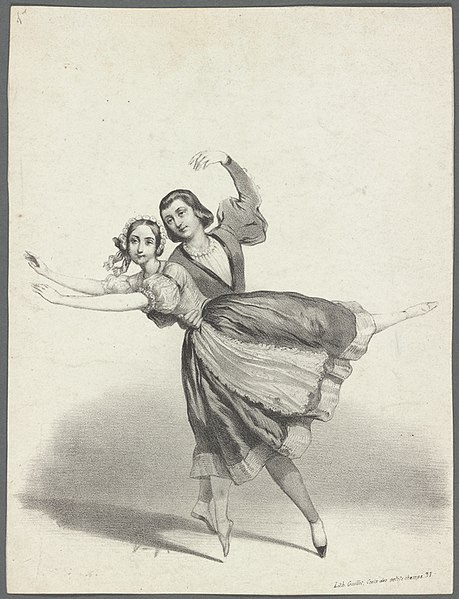In the first part of this series (see here) I looked at a ballet from 1837, during the Romantic Era of ballet. The ballet, Le Chatte, didn’t receive the least performances of the Romantic ballets premiered at the Paris Opera.
That distinction goes to Les Mohicans, which premiered just months before La Chatte, and involves some of the same people. So lets take a look at this ballet, which received a grand total of…2 performances.
The Romantic Era
I wrote a lot in the first part of this series about the Romantic Era of Ballet, so I suggest you read that post before continuing with this one.
But, if you don’t want to, the basic ideas of the movement included the rise of the ballerina, the development of pointe work and the romantic tutu, and it followed the general romantic movement, emphasising the natural over the industrial.

One important part of the romantic ballet was the music. Our ballet today, Les Mohicans, had a score by Adolphe Adam. Of Adam’s ballets Giselle (1841) is most remembered, but he also composed the scores for Le Fille du Danube (1836), Le Diable à quatre and Le Corsaire (1856).
The choreographer was Antonio Guerra. Guerra (1810-1846) was born in Naples, training at the Teatro San Carlo, and achieved a great success at the age of 15 when he was chosen to dance Colas in a revival of La Fille mal gardée. His Paris Opera debut was in November 1836 in La Sylphide, and he’d become a Premier Danseur at the Opera for the next two years.
The ballet itself was based on James Fenimore Cooper’s 1826 novel The Last of the Mohicans. The scenario was seemingly written by dramatist Léon Halévy. Halévy (1802-1883) was the son of Élie Halévy, and the brother of Fromental Halévy, the composer of La Juive fame. I can find no records of Halévy writing another ballet, and some sources attribute the scenario to Guerra. Either way, it was a loose adaptation of the book.
The designers were two of the men responsible for La Chatte, with Monsieurs Devoir and Pourchet designing the ballet. It was common then (and still is now) for sets to be reused, leading to Devoir and Pourchet to reuse a set from an 1835 ballet designed by the other two designers of Le Chatte, Monsieurs Philastre and Chambon. This ballet was Brézilia ou le Tribu des femmes, and was set in South America. Because, as everyone knows, the fauna of North and South America are entirely interchangeable. Critic Théophile Gautier noted that minor changes were made, but it seems no effort had been taken to properly represent the USA’s fauna.
The costumes were by Paul Lormier (1813-1895). Lormier worked extensively with the Paris Opera Ballet during the Romantic Period, costuming ballets like La Tarentule (1839), Giselle (1841), La Péri (1843) and Paquita (1846).

Cast
Nathalie Fitzjames (1819-?) danced the leading female role of Alice. Nathalie was the younger sister of Louise Fitzjames (1809-?), and made her Paris Opera debut at the age of 10, in the small role of Cupid in Sleeping Beauty (this was an 1828 ballet by Jean-Pierre Aumer, not to be confused with the later ballet of the same name by Marius Petipa). Les Mohicans was to be her adult debut. Her most well known originated role today is the female lead of the Peasant Pas de Deux in Act 1 of Giselle.

Elie danced the role of Alice’s dancing-master, Jonathas. Elie was the brother-in-law of Louise Elie, who danced at the Opera from 1810-1835. One of his first known roles at the Paris Opera Ballet was in 1824, so by this time he was a veteran of the company. He originated the role of Gurn in La Sylphide (1832). Elie later taught at the Paris Opera Ballet School from 1846-1848.
Joseph Mazilier (1801-1868) danced the role of Major Arwed. Mazilier originated the role of the Oug Lou in La Chatte, and had been rival to Elie in La Sylphide, originating the role of James. Another future La Chatte cast member, Germain Quériau (1790-1850), danced Alice’s Father, the Colonel.
Guerra himself danced the role of the Mohican Chief, and François Simon danced the role of Hawk-eye, a scout who goes undercover as a Native American.
July 5th & 6th, 1837
The scenario of the ballet has some similarities to the original book. The singing teacher of the book, Gamut, was morphed into Jonathas the dancing-master, which I’d say would be a beneficial change for a ballet. The Major’s name also changes from Heyward to Arwed.
The biggest difference is the plot. In the ballet (which was two acts), the Mohicans raid an English Military Camp, taking prisoner Alice and Jonathas, and wounding the Colonel during their attack. Hawk-eye is sent in as a spy to watch over them (but mostly Alice), and the Chief takes a shine to Alice.
Alice and Jonathas are relying on Major Arwed to be their heroic rescuer, but he shows up in chains, as a prisoner of the Mohicans. The Mohicans aim to burn the Major at the stake, but the day is saved when, instead of the bloodshed that happens in the original book, Jonathas starts playing his violin (a Disney film would have a more violent climax than this).
The violin playing makes the Mohicans want to dance, and they dance themselves to exhaustion. When an English rescue mission arrives the Mohicans aren’t able to put up a resistance. And so, the heroes are free.
Ivor Guest writes that the scenario has already been accepted when Guerra started working on the choreography, and if that’s true, I pity him. Guest also writes that Adam wrote the score in a week, and almost prophetically agreed to be paid in advance in royalties equal to 40 performances. So with that and Giselle, I’d say he came out of this pretty well.
If only the same could be same for the audience, who were not happy with the ballet they paid money to see. The second performance received a worst reception than the first, with the people in the loge infernale (a ground floor box close to the stage, known for having bad sightlines) hissing, despite the presence of the heir to the throne in a nearby box.
Jules Janin, a writer and critic, hoped that the first performance would be the ‘Last of the Mohicans’. He wasn’t write about the first, but he was only wronged because of one more performance.
So why is it forgotten?
A production that gets two performances is never a good one, especially one that was prepared for a debut (in this case Nathalie Fitzjames’). There were rumours amongst her fans that Nathalie had been given an atrocity of a ballet on purpose. We obviously don’t know either way, but the critical consensus seemed to be that Nathalie was given choreography that was too challenging for her, with reviews agreeing she showed promise, but that she needed more time to develop as a dancer. She was sent back to dancing smaller parts.
Happily, she did gain better reviews, starting in 1838. While she was never a top ballerina, she became known for being a valuable dramatic dancer. She’d leave the Opera in 1842, later becoming the first Giselle in Florence and Genoa, and visiting the US between 1850 and 1851.
Adam, the composer, would also better himself, as shown by Giselle. His score for this ballet was described by writer Louis Viardot as ‘facile, agreeable, popular’, and ‘full of marches and repeated pas’. In his review writer Théophile Gautier (who would later write the scenario for Giselle) found particular fault with the scenario and costumes.
We saw this savage ballet of Les Mohicans through to the bitter end with the most profound and sustained concentration, making desperate efforts at understanding something of it. We did not want to demean ourselves by consulting the scenario except in the last resort.
The young Red Indian girls, several of whom look old and starving, are wearing a sort of muslim loincloth- imagine, muslim in the impenetrable forests of America!- adorned with ribbons and feathers that give the impression that they are naked to the waist…..Nor do we believe that savages braid their hair in the Greek fashion…
Théophile Gautier, translated by Ivor Guest in his book Gautier on Dance (2012)
It also seems to have promoted stereotypes of Native Americans. Critics have written much better essays than I could on race relations and racism in Cooper’s original novel, and the novel has been credited with popularising the ‘noble savage’ archetype. Yet in this ballet the Mohicans are antagonistic and savage, and one can only imagine the sort of uncivilised choreography they were given. Gautier writes that the topic of ‘savages’ was unsuitable for a romantic ballet, implying their choreography was indeed savage as well. If this ballet had continued to be performed, it probably would’ve gotten complaints, and rightly so. Perhaps the only upside is the fact that it’s possible someone at the Opera had met Native Americans before.
In 1827 members of the Osage Nation had visited Paris, where they were received with the intrigue that you’d expect. Performances were held for them, they met the King and other diplomats, yet once the novelty had worn off they were reduced to living on the streets. They had to beg for money to secure passage home, while street vendors sold what was essentially unauthorised merchandise. They did manage to return to America in two groups, leaving in 1830 (although it’s assumed two of the six died on the boat home) and apparently spoke fondly of their journey in the following years. Yet this highlights the exploitation of the Native Americans, and the fact that the Parisian public turned them into an archetype they weren’t aiming to be.

So between a ballet that made villains out of ‘noble savages’, an audience who wanted romantic fairies and not ‘savages’, a score that left much to be desired and a scenario that didn’t make sense, it’s perhaps not a surprise that only 2 performances we given. The ballet from last part of this series, George Balanchine’s The Triumph of Neptune, was one I wouldn’t mind seeing a reconstruction of. This, however, would be at the bottom of my list.
Sources
Gautier, Théophile & Guest, Ivor (translation) (2012). Gautier on Dance. Noverre Press, Hampshire, England.
Guest, Ivor (2006). The Paris Opera Ballet. Dance Books, Alton, England.
Guest, Ivor (1966). The Romantic Ballet in Paris. Pitman and Sons, London, England.
Heat Moon, William Least & Wallace, James K. (2015). An Osage Journey to Europe, 1827-1830: Three French Accounts. University of Oklahoma Press, Norman, Oklahoma, USA.
Pingback: Audience Reception: The Good, the Bad and the Ugly | Theatre Journeys